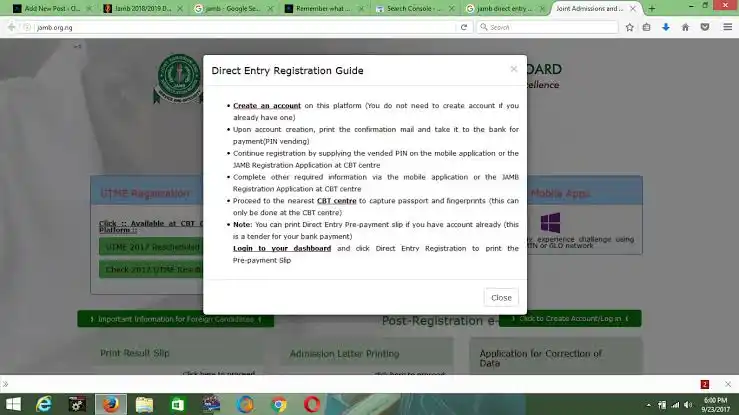JAMB Direct Entry is a special way to get into university for people who have more qualifications than what’s needed for the regular entrance exam (UTME).
It’s made for those with different academic backgrounds, making it easier for them to enter higher institution.
JAMB Direct Entry isn’t just another option; it’s a personalized way to move forward in your studies, considering what makes each person unique.
Table of Contents
Significance of Direct Entry Requirements
Understanding the requirements for JAMB Direct Entry is of paramount importance for several reasons:
1. Access to Higher Education: Direct Entry provides a unique opportunity for candidates with advanced qualifications, such as higher diplomas or A-levels, to gain direct admission to universities.
By knowing the requirements, you can ensure your eligibility and seize this chance.
2. Course Selection: Different courses may have specific Direct Entry prerequisites.
Being aware of these requirements empowers you to make informed decisions about your desired field of study and the subjects you need to excel in.
3. Preparation and Planning: Knowledge of Direct Entry criteria allows you to plan your academic journey effectively.
You can take the necessary steps well in advance, ensuring you meet all the requirements and deadlines.
4. Reducing Errors: Understanding Direct Entry requirements minimizes the risk of making mistakes during the application process.
This helps you avoid potential setbacks and delays in your pursuit of higher education.
5. Competitive Advantage: Being well-informed about Direct Entry puts you ahead of the competition.
It allows you to focus your efforts on meeting the criteria and presenting a strong application, increasing your chances of securing admission.
What is JAMB Direct Entry?
JAMB Direct Entry is a unique admission process designed for candidates who possess qualifications beyond the scope of the standard UTME requirements.

Unlike the UTME, which primarily evaluates candidates based on their performance in a standardized examination, Direct Entry considers additional qualifications and academic achievements. These qualifications may include:
1. Higher Diplomas: Candidates who have completed higher diploma programs, often obtained from polytechnics and colleges of education.
2. A-levels and IJMB: Individuals who have completed Advanced Level (A-level) or Interim Joint Matriculation Board (IJMB) programs, which are equivalent to the first year of university education.
3. National Diploma (ND) and National Certificate of Education (NCE): Graduates of ND and NCE programs who wish to further their education at the university level.
4. Bachelor’s Degrees: Holders of bachelor’s degrees who intend to pursue additional degrees in related or different fields.
JAMB Direct Entry recognizes these advanced qualifications and provides a streamlined process for eligible candidates to gain direct admission into universities.
It acknowledges that education is not a one-size-fits-all journey and caters to the diverse academic backgrounds of applicants.
Distinction between JAMB UTME and Direct Entry
To better grasp the concept of JAMB Direct Entry, it’s important to contrast it with the traditional JAMB UTME:
1. Purpose: JAMB UTME is primarily designed for secondary school leavers who are seeking admission into universities for their first-degree programs.
Direct Entry, on the other hand, is tailored for candidates with advanced qualifications beyond the secondary school level.
2. Examination: UTME involves a standardized examination that assesses candidates’ knowledge in subjects like Mathematics, English, and other relevant subjects.
Direct Entry candidates, while they may still take the UTME, are primarily evaluated based on their advanced qualifications, which vary depending on their academic backgrounds.
3. Eligibility: UTME is open to secondary school graduates who have completed their Senior Secondary Certificate Examinations (SSCE) or its equivalent.
Direct Entry is open to candidates with higher qualifications, such as A-levels, ND, NCE, or bachelor’s degrees.
4. Course Duration: UTME candidates typically start their undergraduate programs from the first year, while Direct Entry candidates can gain admission into higher levels, often starting from the second year of their chosen course.
Eligibility for JAMB Direct Entry
JAMB Direct Entry represents a valuable opportunity for individuals with advanced academic qualifications to gain direct admission into Nigerian universities and other tertiary institutions.

To embark on this educational journey, it’s essential to understand the eligibility criteria, including the academic qualifications required and who is eligible to apply for Direct Entry.
Academic Qualifications Required
1. Advanced Level (A-level) Certificate: One of the primary qualifications accepted for JAMB Direct Entry is an A-level certificate. This certificate typically includes subjects relevant to the chosen course of study and is obtained after completing a two-year A-level program.
2. Interim Joint Matriculation Board (IJMB) Certificate: IJMB is another recognized qualification for Direct Entry. It is the equivalent of the first year of university education and is particularly popular among candidates who wish to gain admission directly into the second year of a degree program.
3. National Diploma (ND) and National Certificate of Education (NCE): Graduates of ND and NCE programs are eligible for Direct Entry. These qualifications are often obtained from polytechnics and colleges of education, respectively.
4. Bachelor’s Degree: If you already hold a bachelor’s degree and are seeking admission for a higher degree (e.g., a master’s or another bachelor’s degree in a different field), you can apply for Direct Entry.
5. Cambridge A’Level Certificate: The Cambridge A’Level certificate, with relevant subjects, is also recognized for JAMB Direct Entry.
It’s important to note that the specific requirements may vary depending on the university or institution and the course of study. Therefore, applicants should check with their chosen institution for detailed eligibility criteria.
Who Can Apply for Direct Entry?
JAMB Direct Entry is open to a wide range of candidates who meet the eligibility criteria. The following categories of individuals can apply for Direct Entry:
1. Advanced Certificate Holders: Those who have completed A-level programs and obtained the necessary certificate.
2. IJMB Graduates: Candidates who have completed the IJMB program and achieved the required grades.
3. ND and NCE Graduates: Graduates of National Diploma (ND) and National Certificate of Education (NCE) programs who aspire to further their education.
4. Bachelor’s Degree Holders: Individuals with existing bachelor’s degrees who seek additional degrees or postgraduate studies.
5. Candidates with Equivalent Qualifications: Some candidates may possess qualifications equivalent to the ones mentioned above, and they are also eligible to apply.
It’s important to emphasize that while Direct Entry offers a unique pathway to higher education, meeting the eligibility criteria is just the first step.
Candidates must also complete the JAMB Direct Entry registration process and meet any additional requirements specified by their chosen institution.
Understanding these eligibility criteria and adhering to the application procedures is essential for a smooth and successful transition into higher education through JAMB Direct Entry.
Read Also: Jamb Reprint: Simple Steps On How To Print Your UTME Exam Slip In 2024
Documents Needed for JAMB Direct Entry
When applying for JAMB Direct Entry, it’s imperative to ensure that you have all the necessary documents to facilitate a smooth and successful admission process.
Below is a comprehensive list of the documents that applicants must provide and an explanation of the importance of proper documentation:
List of Documents Applicants Must Provide
1. JAMB Direct Entry Registration Form: This form is the foundation of your application. It contains essential information about your details, chosen course, and institution preferences.
2. O’Level Result(s): Copies of your O’Level results, such as the Senior Secondary School Certificate Examination (SSCE) or its equivalent. These documents showcase your academic qualifications and are crucial for course eligibility.
3. A-Level, IJMB, ND, NCE Certificates: If applicable, include certified copies of your advanced qualifications, such as A-level certificates, IJMB certificates, or National Diploma (ND) and National Certificate of Education (NCE) certificates.
4. Bachelor’s Degree Certificate (if applicable): For candidates seeking admission for a higher degree, a copy of your bachelor’s degree certificate is necessary.
5. Birth Certificate or Declaration of Age: Proof of your date of birth is required for age verification.
6. JAMB Result Slip: A copy of your JAMB Direct Entry result slip obtained after registration.
7. Passport Photographs: Recent passport-sized photographs with a white background are essential for identification purposes.
8. Local Government Identification: Proof of your local government area of origin or residence.
9. State of Origin Certificate: This document may be required for some state universities to verify your state of origin.
10. Evidence of Change of Name (if applicable): If your name has changed due to marriage or other reasons, provide the necessary documentation to support the change.
Importance of Proper Documentation
1. Verification of Eligibility: Proper documentation ensures that you meet the eligibility criteria for JAMB Direct Entry.
Your certificates and records serve as evidence of your qualifications and readiness for higher education.
2. Smooth Application Process: Having all the required documents readily available streamlines the application process.
It reduces the risk of delays and ensures that you can complete your application within the stipulated deadlines.
3. Course of Study Confirmation: Many institutions require specific documents to verify your eligibility for particular courses.
Proper documentation allows you to confirm your chosen course of study without complications.
4. Institutional Requirements: Different universities and tertiary institutions may have additional document requirements.
Being well-prepared with the necessary documents ensures that you meet these specific institutional requirements.
5. Reducing Errors: Accurate documentation reduces the likelihood of errors or discrepancies in your application, which could lead to complications or disqualification.
6. Verification of Identity: Passport photographs and identification documents help verify your identity during the admission process, ensuring that you are the rightful applicant.
JAMB Direct Entry Registration Process
The JAMB Direct Entry registration process is a crucial step for candidates aspiring to gain direct admission into Nigerian universities and tertiary institutions.
To help you navigate this process effectively, we provide a step-by-step guide and highlight important dates and deadlines to ensure a smooth application experience.
Step-by-Step Guide to Registering for Direct Entry
1. Create a JAMB Profile: Visit the official JAMB registration portal (https://efacility.jamb.gov.ng/). Click on Create an Account to begin the registration process. Provide your valid email address and mobile phone number.

A confirmation code will be sent to your email and phone for verification. Use the code to complete your profile registration.
2. Purchase the JAMB Direct Entry E-PIN: Visit an authorized bank or JAMB office to purchase the Direct Entry E-PIN. Provide your JAMB profile code and pay the required fee. You will receive the E-PIN and a registration CD at the bank or JAMB office.
3. Complete Your Registration Online: Visit the JAMB registration portal again. Log in with your email and profile code. Fill in the necessary biographical information and select your preferred institution and course of study.
Upload your passport-sized photograph and other required documents.
4. Review Your Registration: Carefully review all the information provided for accuracy. Make corrections if necessary and verify that your documents are properly uploaded.
5. Print Your Registration Slip: Once your registration is complete and error-free, print your registration slip. This slip contains important details, including your examination date, time, and venue.
6. Payment of Exam Fees: Pay the examination fee using the E-PIN at authorized banks, online payment platforms, or through other approved payment methods.
7. JAMB Direct Entry Examination: On the specified date, go to the examination center indicated on your registration slip. Present your slip and valid identification for verification. Take the Direct Entry examination as scheduled.
8. Check Your Results: After taking the examination, check your results on the JAMB portal.
Important Dates and Deadlines
The JAMB Direct Entry registration period typically opens several months before the examination date.
It is essential to monitor the official JAMB website and announcements for the exact opening and closing dates for each registration cycle.
The JAMB Direct Entry examination is usually scheduled to take place on a specified date, which will be communicated through the official JAMB portal and other channels.
Candidates should pay close attention to the deadline for purchasing the Direct Entry E-PIN, as well as the deadline for completing the online registration. Late registration may not be accepted.
It’s advisable to register well in advance to avoid last-minute hassles and to ensure you have sufficient time to prepare for the examination.
Read Also: 2024 JAMB Regularization: Know The Best Step By Step Procedure
JAMB Direct Entry Subject Combinations
Understanding the subject combinations required for JAMB Direct Entry is crucial for candidates seeking admission into Nigerian universities and tertiary institutions.
This knowledge not only ensures eligibility but also paves the way for a successful application process. In this section, we will explain subject combinations for various courses and guide you on how to choose the right subjects for your desired course.
Explanation of Subject Combinations for Various Courses
1. Science and Engineering Courses: For courses in fields like Engineering, Medicine, Physics, Chemistry, and Biology, the typical subject combination includes Physics, Chemistry, and Biology/Mathematics.
2. Social Sciences and Management Courses: Subjects like Economics, Accounting, Business Administration, Political Science, and Sociology often require Economics, Mathematics, and any other Social Science or Arts subject.
3. Arts and Humanities Courses: For courses in the Arts and Humanities, such as History, English Language, Linguistics, and Theatre Arts, the subject combination may include Literature in English, a Nigerian Language, and any other relevant Arts or Social Science subject.
4. Medical and Health Sciences Courses: Courses like Medicine, Pharmacy, Nursing, and Dentistry usually require Physics, Chemistry, and Biology.
5. Law: Law programs typically require Literature in English and any two other Arts or Social Science subjects.
6. Agriculture and Environmental Science Courses: Courses like Agriculture, Environmental Science, and Forestry may require subjects such as Chemistry, Biology, and Physics/Mathematics.
7. Education Courses: Subject combinations for Education courses vary depending on the intended teaching subject. For example, to teach Mathematics, you may need Mathematics and two other relevant subjects.
How to Choose the Right Subjects for Your Desired Course
Choosing the right subjects for your desired course is a critical decision that can significantly impact your eligibility for JAMB Direct Entry.
Here’s a step-by-step guide to help you make the right choices:
1. Research Your Chosen Course: Begin by thoroughly researching the specific subject requirements for the course you intend to study. You can find this information on the JAMB website or the website of your chosen institution.
2. Review Your Academic Interests: Consider your academic strengths and interests. Choose subjects that align with your abilities and passion. This will not only enhance your performance but also contribute to your academic success.
3. Consult with Educational Counselors: Seek guidance from educational counselors, teachers, or mentors who can provide insights into subject choices based on your career aspirations.
4. Check JAMB Brochure: The JAMB brochure is a valuable resource that provides subject requirements for various courses. Refer to it to ensure you’re on the right track.
5. Confirm Institution-Specific Requirements: Some universities may have specific subject requirements for certain courses. Always double-check with your chosen institution to ensure you meet their criteria.
6. Balance Your Choices: While choosing subjects that align with your course is essential, ensure a balanced combination that allows you to excel in all subjects.
7. Practice Past Questions: Familiarize yourself with past JAMB Direct Entry questions for your chosen course to understand the level of difficulty and the areas to focus on during your preparation.
JAMB Direct Entry Screening
The JAMB Direct Entry screening process is a crucial step in the journey toward gaining direct admission into Nigerian universities and tertiary institutions.
This stage serves to verify candidates’ qualifications and eligibility for their chosen courses. In this section, we’ll provide an overview of the screening process and offer tips to ensure a successful screening experience.
Overview of the Screening Process
1. Application Submission: After completing your JAMB Direct Entry registration and satisfying all document requirements, you’ll submit your application to your chosen institution(s).
The institution will typically provide specific guidelines for application submission, including deadlines.
2. Document Verification: The institution’s admission office will review your application and verify the authenticity of your documents. This step involves cross-checking your academic qualifications, O’Level results, and other relevant documentation.
3. Screening Exercise: Some institutions may conduct a physical or online screening exercise as part of their admission process.
This exercise may include written tests, oral interviews, or group discussions, depending on the institution’s requirements.
4. Merit List Publication: Upon successful completion of the screening exercise and document verification, the institution will publish a merit list of candidates who meet their criteria.
This list typically includes the names of candidates who have been offered provisional admission.
5. Payment of Acceptance Fees: If you are offered provisional admission, you will be required to pay acceptance fees to secure your place in the institution. This fee confirms your intention to enroll in the program.
6. Registration: After payment of acceptance fees, you will proceed with the institution’s registration process, which includes course registration, payment of tuition fees, and other administrative procedures.
7. Commencement of Academic Activities: Once you have completed the registration process, you will officially begin your academic journey in your chosen institution.
Tips for a Successful Screening
1. Prepare Your Documents: Ensure that all required documents are readily available and in good condition. This includes your O’Level results, certificates, Direct Entry registration slip, and any other documents specified by the institution.
2. Review the Institution’s Guidelines: Familiarize yourself with the specific requirements and guidelines provided by the institution you are applying to. Follow these guidelines meticulously to avoid any discrepancies.
3. Be Punctual: If there is a physical screening exercise, arrive at the venue on time. For online screenings, adhere to the specified deadlines for submission.
4. Dress Appropriately: If the screening involves an interview or physical exercise, dress neatly and professionally. First impressions matter.
5. Practice for the Screening: If the institution conducts written tests or interviews, practice beforehand. Review your academic materials and prepare answers to common interview questions.
6. Stay Informed: Keep yourself updated on any communication from the institution. Check your email regularly and visit the institution’s website for updates.
7. Maintain Professionalism: During interviews or group discussions, maintain a professional demeanor, be confident, and express yourself clearly.
8. Keep Records: Maintain copies of all your application documents, including receipts for payments made. These can be useful for reference and as proof of compliance.
9. Follow-Up: If you have not received feedback within the stipulated time frame, consider following up with the institution’s admission office to inquire about your application status.
Read Also: Your Ultimate Guide for Printing JAMB Exam Slip In 2024
Common Mistakes to Avoid in JAMB Direct Entry Applications
JAMB Direct Entry applications are crucial in the pursuit of higher education in Nigeria, and avoiding common mistakes is vital to ensure a seamless application process. Below, we outline some typical errors made by Direct Entry applicants and guide how to prevent them.
Common Errors Made by Direct Entry Applicants
1. Incomplete Documentation: Failing to provide all required documents, such as O’Level results, transcripts, or certificates, can lead to application rejection.
2. Late Application: Missing application deadlines is a common pitfall. Late applications are typically not accepted, so it’s essential to submit your application on time.
3. Incorrect Subject Combinations: Choosing the wrong subject combinations for your desired course can disqualify you from admission. It’s crucial to thoroughly research and select the appropriate subjects.
4. Failure to Verify Eligibility: Some applicants assume they are eligible without checking the specific requirements for their chosen course. This can result in wasted time and resources.
5. Impersonation: Attempting to apply or sit for the JAMB Direct Entry examination on behalf of someone else is a grave offense that can lead to severe consequences, including legal actions.
6. Forgery: Providing false documents or tampering with certificates is a serious mistake that can result in disqualification and legal repercussions.
7. Ignoring Instructions: Neglecting to follow application guidelines provided by JAMB and the chosen institution can lead to errors and disqualification.
8. Incomplete Application Forms: Failing to fill out all required sections of the application form can result in incomplete submissions, leading to disqualification.
How to Prevent These Mistakes
1. Thorough Documentation: Ensure that all required documents are complete, legible, and in good condition. Keep them well-organized and readily accessible.
2. Application Calendar: Mark important application dates on your calendar and set reminders to avoid missing deadlines. Start the application process well in advance.
3. Research Your Course: Consult the JAMB brochure and the specific institution’s website to verify the subject requirements for your chosen course. Seek clarification if needed.
4. Eligibility Check: Review the eligibility criteria for your intended course, ensuring you meet all requirements before applying.
5. Personal Presence: Avoid engaging in impersonation or any fraudulent activities. Only apply for yourself and participate in the examination honestly.
6. Authenticity: Do not submit false documents or engage in forgery. Authenticity is crucial in the application process.
7. Read and Follow Instructions: Carefully read and adhere to all instructions provided in the JAMB brochure, on the JAMB website, and by the institution you are applying to.
8. Complete the Application Form Thoroughly: Fill out all sections of the application form accurately and completely. Double-check your entries before submission.
9. Seek Guidance: If you are uncertain about any aspect of the application process, don’t hesitate to seek guidance from educational counselors, teachers, or mentors.
10. Stay Informed: Continuously check your email and the official JAMB website for updates and important information related to your application.
Frequently Asked Questions (FAQs) about JAMB Direct Entry
The JAMB Direct Entry process can be complex, and applicants often have various questions.
Here, we provide clear and concise answers to some of the most commonly asked questions to assist you in your Direct Entry journey.
Q1: What is JAMB Direct Entry?
JAMB Direct Entry is a specialized admission process in Nigeria that allows candidates with advanced qualifications, such as A-levels, ND, NCE, or bachelor’s degrees, to gain direct entry into universities and tertiary institutions without taking the traditional UTME examination.
Q2: What are the eligibility criteria for JAMB Direct Entry?
Eligibility varies depending on the institution and the course of study. Typically, candidates should possess qualifications like A-levels, IJMB, ND, NCE, or bachelor’s degrees. Specific subject requirements may apply.
Q3: How do I apply for JAMB Direct Entry?
To apply for JAMB Direct Entry, create a JAMB profile, purchase the Direct Entry E-PIN, complete the online registration, and submit the required documents. Detailed instructions are available on the JAMB website.
Q4: What is the difference between JAMB UTME and Direct Entry?
JAMB UTME is for secondary school leavers seeking admission into universities for their first degree, while Direct Entry is for candidates with advanced qualifications beyond the secondary level who wish to gain direct admission into higher education institutions.
Q5: Are there specific subject combinations for JAMB Direct Entry?
Yes, subject combinations vary by course. It’s crucial to consult the JAMB brochure and the chosen institution’s requirements to determine the correct subjects for your desired course.
Q6: Can I change my course or institution after applying for JAMB Direct Entry?
Yes, you can change your course or institution. JAMB provides a change of course/institution portal for this purpose. However, it’s important to note the specified deadlines for such changes.
Q7: What happens if I miss the application deadline for JAMB Direct Entry?
Missing the application deadline can result in your application not being considered for the current admission cycle. It’s essential to adhere to all provided deadlines to avoid such issues.
Q8: When is the JAMB Direct Entry examination conducted?
The examination date varies each year. JAMB will announce the examination date on its official website. Be sure to check the website regularly for updates.
Q9: How can I check my JAMB Direct Entry result?
To check your JAMB Direct Entry result, visit the JAMB portal, log in with your registration number, and follow the instructions provided to access your result.
Q10: What should I do if I have a problem during the Direct Entry screening process?
If you encounter any issues during the screening process, promptly contact the institution’s admission office for assistance. They can provide guidance and solutions to resolve the problem.
These frequently asked questions and their answers aim to provide clarity and guidance for JAMB Direct Entry applicants.
For further information or specific inquiries, it is advisable to visit the official JAMB website or contact the relevant institution’s admission office.
Conclusion
Understanding the rules for JAMB Direct Entry is really important for your education in Nigeria. This special way of getting into college is for people with extra qualifications. Knowing the basics can really help you in your studies.
Why Knowing JAMB Direct Entry Rules is Crucial
1. Getting into College: JAMB Direct Entry is a chance for people with qualifications beyond the regular UTME to directly get into universities and other schools.
2. Smart Choices: If you know the right subjects and criteria, you can make good choices about what to study and plan your education well.
3. Planning Ahead: Knowing the Direct Entry rules helps you plan your education, making sure you meet all the criteria and deadlines.
4. Avoiding Mistakes: If you understand the rules, you’re less likely to make mistakes when applying, avoiding problems later.
5. Standing Out: Knowing about Direct Entry makes you a strong candidate. It lets you focus on meeting the criteria, improving your chances of getting in.
Advice for Students Getting Ready
As you start the JAMB Direct Entry process, make sure you get ready properly. Here’s what you should do:
- Research the requirements for your course and school.
- Collect and check all the documents you need.
- Practice for any tests or interviews that might be part of the process.
- Stay organized and stick to deadlines.
- Get help from counselors or mentors when you need it.
- Stay positive and determined to overcome challenges.
Getting ready like this will help you apply smoothly and succeed. Remember, JAMB Direct Entry isn’t just another way; it’s a chance to chase your education dreams with confidence.
As you go for higher education through JAMB Direct Entry, may you find fulfillment, growth, and success in your chosen field.
Get ready well, aim high, and embrace the opportunities waiting for you in your educational journey.
Your future looks bright, and with good preparation, you can reach your academic goals.
Read Also: JAMB eFacility Portal: Easy Steps for Accessing The portal In 2024






